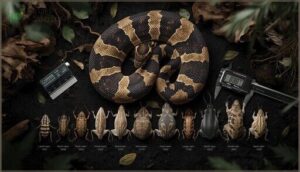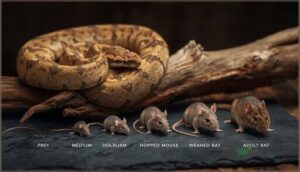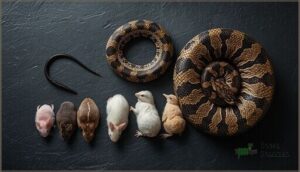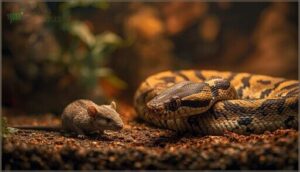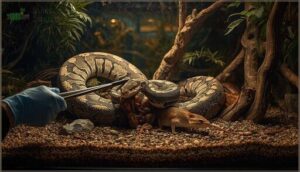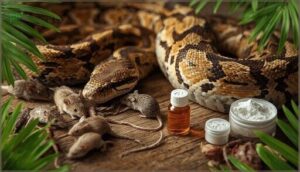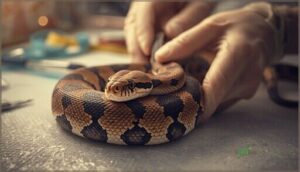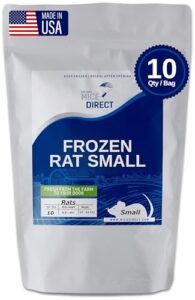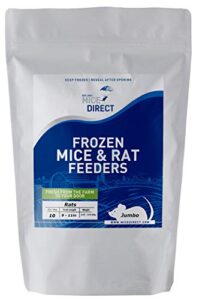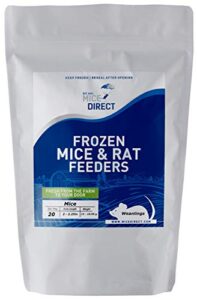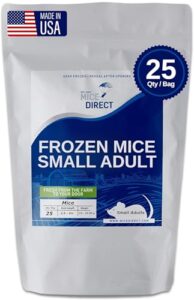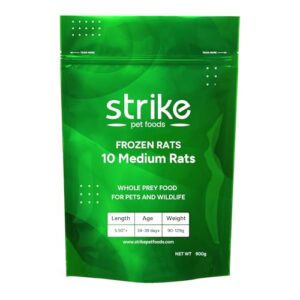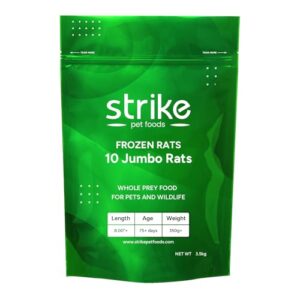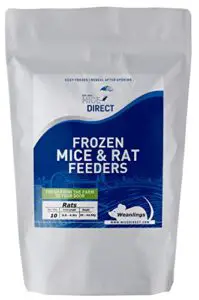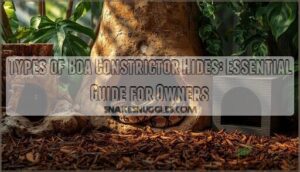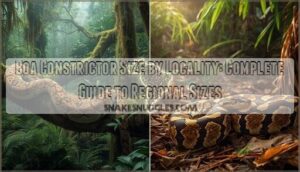This site is supported by our readers. We may earn a commission, at no cost to you, if you purchase through links.
A boa constrictor that refuses food for weeks, then gorges until it regurgitates, isn’t being difficult—it’s responding to improper feeding protocols that conflict with its physiology. Unlike mammals with daily metabolic demands, boas process meals over extended periods, requiring precise attention to prey size, feeding intervals, and environmental conditions.
Missteps in any of these variables compromise digestion, stunt growth, or trigger stress responses that cascade into chronic health problems. Establishing a feeding routine that aligns with your boa’s age, body condition, and seasonal rhythms transforms what seems unpredictable into a systematic process.
Mastering these protocols means understanding the relationship between prey selection, thermal gradients, and digestive efficiency—each element supporting the others to maintain peak health throughout your snake’s lifespan.
Table Of Contents
- Key Takeaways
- Boa Constrictor Feeding Schedules and Frequency
- Choosing The Right Prey Size and Type
- Safe and Effective Feeding Techniques
- Essential Nutritional Supplements for Boas
- Monitoring Boa Health and Body Condition
- Optimizing Boa Constrictor Habitat for Feeding
- Top 10 Frozen Prey Products for Boa Constrictors
- 1. Strike Large Frozen Rats Snake Food
- 2. Frozen Feeder Mice for Snakes Reptiles
- 3. MiceDirect Frozen Small Rats Snake Food
- 4. MiceDirect Premium Frozen Jumbo Rat Feeders
- 5. Frozen Weanling Mice Snake Feeders
- 6. Frozen Mice Small Adult Snake Feeders
- 7. STRIKE Medium Frozen Rats Snake Food
- 8. Strike Jumbo Frozen Rats Snake Food
- 9. MiceDirect Frozen Weanling Rats Reptile Food
- 10. Strike Frozen Rats Snake Food
- Frequently Asked Questions (FAQs)
- Conclusion
Key Takeaways
- Feed juvenile boas every 10–14 days with prey at 8–10% body weight, then extend intervals to 14–21 days for subadults and 4–8 weeks for adults, adjusting frequency during cooler months when metabolism slows to prevent regurgitation.
- Match prey width to 1.0–1.5 times your boa’s mid-body diameter and keep meal weight at 5–10% of total body mass, using frozen-thawed rodents exclusively to eliminate bite injuries and parasite risks while maintaining proper calcium-to-phosphorus ratios.
- Never handle your boa within 48 hours after feeding to avoid triggering regurgitation, and maintain basking temperatures at 86–90°F with a thermal gradient down to 75–80°F to support efficient digestion across the 4–6 day gastric processing period.
- Monitor body condition monthly for the “loaf-shaped” cross-section that indicates proper weight—visible fat rolls or triangular body shape signal overfeeding or underfeeding that requires immediate feeding schedule adjustments to prevent metabolic disease.
Boa Constrictor Feeding Schedules and Frequency
Feeding your boa constrictor on the right schedule makes all the difference between a healthy, thriving snake and one that’s struggling. The frequency depends on your snake’s age, size, and even the time of year, since their metabolism shifts with temperature changes.
Let’s break down how often you should feed at each life stage and what signs tell you it’s time to adjust your approach.
Feeding Intervals by Age and Size
Feeding frequency for boa constrictors shifts dramatically as your snake matures, and understanding these age-based feeding intervals prevents both malnutrition and obesity. Here’s how to adjust prey correlation with growth stages:
- Neonate intervals: Feed every 7–10 days with prey at 8–10% body weight
- Juvenile frequency: Every 10–14 days for ages 6–18 months
- Subadult moderation: Move to 14–21 day intervals as metabolism slows
- Adult tolerances: Mature boas thrive on 4–8 week schedules
- Prey size guidelines for boa constrictors: Maintain 5–10% body mass ratio throughout life
Juveniles demand frequent meals for rapid development, while adults tolerate extended intervals without health compromise. A balanced diet is essential, so feed rodents like rats and mice to your boa.
Adjusting Feeding During Cooler Months
As winter sets in, your boa’s metabolism slows and feeding intervals naturally extend. Temperature changes drive this seasonal rhythm: neonates move from 7–10 days to 10–14 days between meals, while adults may stretch to 6–8 weeks. Stop feeding 2–3 weeks before any intentional cooling to clear the gut. During winter feedings, maintain basking zones at 86–90°F and consider slightly smaller prey to ease digestion. Boa constrictors thrive when provided with a proper temperature gradient.
| Age Group | Summer Interval | Winter Interval |
|---|---|---|
| Neonates | 7–10 days | 10–14 days |
| Subadults | 14 days | 30 days |
| Adults | 30 days | 70–90 days |
Monitor for regurgitation or refusal after adjusting seasonal feeding practices—these signal improper temperature management or prey size. Brumation fasting protocols guarantee safe metabolic slowdown, while careful prey adjustment and monitoring response prevent digestive stress throughout cooler months.
Feeding Frequency for Juveniles, Subadults, and Adults
Beyond seasonal adjustments, age-based feeding frequency dictates your boa’s long-term health. Juveniles thrive on 10–14 day intervals, supporting 1,200–1,400% relative growth over their first year. Subadults move to 14-day schedules, while adults require only 30-day intervals—weekly feeding in mature boas risks obesity.
Research confirms higher feeding frequency accelerates juvenile growth (mean final mass 1,818 g weekly vs. 1,425 g biweekly), yet adults maintain lean condition on monthly meals.
Recognizing Signs to Adjust The Schedule
Setting the right feeding schedule is half the battle—knowing when to change it completes the picture. Your boa’s behavior, body condition, and digestive patterns reveal whether your current intervals are working.
Watch for these health indicators requiring schedule adjustment:
- Increased hunting behavior or tongue-flicking before scheduled meals signals hunger
- Visible fat rolls or triangular body shape indicate overfeeding or underfeeding
- Irregular defecation patterns suggest digestive slowdown needing longer intervals
- Reduced appetite during seasonal changes justifies temporary frequency reduction
Clinical signs like unexplained weight loss exceeding 10% body mass demand immediate veterinary review and feeding schedule modification.
Choosing The Right Prey Size and Type
Selecting the right prey size directly impacts your boa’s digestion, growth rate, and overall health. If the meal is too large, you risk regurgitation and metabolic stress; too small, and your snake won’t receive adequate nutrition to thrive.
Let’s examine the specific guidelines that will help you match prey to your boa’s current life stage and body condition.
Prey Width and Weight Guidelines
You’ll want to match prey width to your boa’s thickest body section—generally 1.0 to 1.5 times mid-body diameter—while keeping prey weight around 5 to 10% of the snake’s total mass.
A boa constrictor feeding chart often lists categories by prey weight: hoppers at 8–12 g, medium mice at 17–20 g, weaned rats at 33–49 g, and adults receiving larger rats up to 200 g or more, depending on body condition.
Matching Prey Size to Boa’s Growth Stage
Since neonates under six months digest fuzzy mice or pinky rats best every 10–14 days, you’ll minimize regurgitation impact with prey at 8–12 g.
Juveniles weighing 67–155 grams handle hopper mice of similar mass, while subadults sizing up to 455 grams tolerate weaned rats at 17–45 g.
Adults matching 1,000+ grams accept small to medium rats around 85–140 g, with incremental increases never exceeding 20% between feedings to support steady growth.
Recommended Prey Types for Boas
Rodent nutrition anchors your feeding strategy because frozen rats deliver twice the calcium of mice while offering leaner protein ratios for adult boas. Whole-prey form ensures complete micronutrient profiles that processed options can’t match. You’ll maintain digestive health by rotating prey items across mammalian variety—rabbits for large females, day‑old chicks as avian alternatives a few times yearly, and occasional hamsters to mirror wild generalist diets.
- Frozen rats remain the staple prey type, with calcium content double that of mice supporting skeletal integrity
- Day‑old chicks serve as lower‑fat avian alternatives when offered sparingly to less active adults
- Rabbits and other mammals expand prey selection for boas exceeding 1,000 grams without nutritional compromise
- Reptile inclusion mirrors natural diets but carries higher parasite risks than commercially frozen prey
- Prey size progression from 8‑gram pinkies to 374‑gram extra‑large rats matches each growth stage’s gape capacity
Preventing Regurgitation With Proper Prey Selection
Regurgitation often signals prey selection errors rather than digestive failure. Overfeeding risks spike when handling methods disrupt digestion within 48 hours post-feeding.
You’ll cut regurgitation risk by capping prey at 1.5 times your boa’s body diameter and keeping meals under 10% body weight. Thawing frozen prey completely prevents internal cold shock, while gut recovery demands 10–14-day intervals after any regurgitation event before resuming normal feeding frequency.
Safe and Effective Feeding Techniques
Feeding your boa constrictor safely requires more than just dropping prey into the enclosure. The right techniques protect both you and your snake, reducing stress and preventing injuries during mealtime.
Here are the key methods that guarantee safe, consistent feeding success.
Using Frozen-thawed Prey
Frozen prey offers a safer, more practical alternative to live feeding, reducing zoonotic risks and eliminating the threat of rodent bites to your snake. Freezer storage at -18°C maintains quality for six months, though nutritional degradation does affect vitamins like thiamine during extended storage periods.
- Over 90% of captive boas accept thawed prey after initial exposure
- Scenting techniques boost acceptance rates above 85% for reluctant feeders
- Proper prey presentation with feeding tongs simulates natural movement effectively
Thawing and Warming Procedures
Proper thawing of frozen prey begins with refrigeration at 40°F for two hours for mice or four to five hours for rats—the safest method to limit bacterial growth.
After refrigeration, you’ll warm the prey in water around 95–100°F for ten to twenty minutes until it reaches mammalian body temperature, triggering your boa’s feeding response.
Never microwave or refreeze thawed prey; both practices introduce serious health risks.
Feeding With Tongs for Safety
Once your thawed prey reaches the right temperature, using feeding tongs becomes your first line of defense against bite risk reduction and injury prevention. Stainless-steel tongs 25–30 cm long keep your hands outside the strike zone while minimizing zoonotic exposure from Salmonella-contaminated rodent surfaces.
- Equipment specs recommend soft-tipped tongs to prevent oral trauma during strikes
- Behavioral management improves when your boa associates the tool with feeding, not your hands
- Prey handling from mid-body simulates natural movement in the feeding enclosure
Disinfect tongs after each use to maintain hygiene between feeding techniques.
Handling Boas During Feeding
Beyond the tongs themselves, your timing matters more than technique. Strike risk doubles within 48 hours of feeding, so avoid handling entirely on prey presentation days or when rapid tongue flicks signal heightened feeding response.
Disturbing digestive processes triggers regurgitation risks—protocol effectiveness depends on a strict 48-hour hands-off period.
Tap your boa gently with a hook before routine handling to distinguish care from feeding techniques, reducing stress signals and injury prevention concerns by half.
Essential Nutritional Supplements for Boas
While rodents provide the foundation of your boa’s diet, they don’t always deliver complete nutrition on their own. Strategic supplementation with calcium and vitamin D3, combined with proper prey preparation techniques, ensures your snake receives everything needed for best bone health, muscle function, and long-term vitality.
Below, you’ll find practical approaches to supplementing your boa’s diet and maintaining nutritional balance throughout its life.
Calcium and Vitamin D3 Supplementation
Without the right mineral supplements, your boa’s bones can weaken, leading to metabolic bone disease (MBD). Calcium absorption depends on vitamin D3, which you can provide through UVB lighting or dietary supplementation. Here’s what you need to know about proper supplementation:
- Calcium powder with D3: Use once or twice monthly if you don’t provide UVB lighting; avoid over-supplementation risks that cause soft tissue calcification.
- Supplement forms: Calcium carbonate contains 40% elemental calcium but absorbs less efficiently than calcium citrate.
- Vitamin D3 dosage: Keep supplements under 20,000 IU/kg to prevent mineral imbalances and renal dysfunction.
Whole-prey diets generally meet adult boas’ calcium requirements naturally.
Dusting and Gut-loading Prey
You can boost your boa’s supplement absorption by dusting prey with commercial calcium powder and vitamin D3 before feeding. Apply supplements every 2-3 feedings for juveniles, reducing frequency as they mature to avoid vitamin toxicity.
Gut-loading prey with nutrient-rich chow for 24-48 hours beforehand increases calcium by 19% and reduces metabolic bone disease risk by 16%, delivering mineral supplements through the prey itself.
Maintaining a Balanced Diet
You maintain your boa’s metabolic needs by rotating prey types and matching feeding frequency to body condition and age. Balanced nutrition requires monitoring prey size relative to growth stage, making sure dietary variety helps nutrient absorption without excess supplementation.
- Adjust feeding intervals when you notice weight changes or reduced activity levels
- Rotate between rats and appropriate-sized rabbits to prevent nutritional monotony
- Time supplements strategically—calcium before feeding, multivitamins weekly
- Monitor hydration importance by providing fresh water immediately post-meal
- Track body condition monthly to fine-tune your boa’s nutritional needs
Foods to Avoid for Boa Constrictors
Although whole rodents meet dietary needs, certain prey items threaten your boa’s health. Thiaminase fish and boneless meats lack essential nutrients and calcium, while immature prey with underdeveloped skeletons promote metabolic bone disease.
High-fat prey increases obesity and regurgitation risk, and unsafe prey can cause gastrointestinal obstruction or impaction. These feeding errors lead to chronic health issues requiring veterinary intervention.
Monitoring Boa Health and Body Condition
Keeping your boa constrictor healthy means watching how its body looks and changes over time. You need to recognize what a well-fed snake looks like versus one that’s too heavy or too thin.
Let’s break down the key indicators that tell you whether your feeding routine is working or needs adjustment.
Identifying a Healthy Boa Constrictor
A healthy boa constrictor displays clear, objective health indicators you can monitor routinely. Observe body condition carefully: muscle definition should be firm, activity levels consistent with nocturnal habits, and appetite steady.
Key markers include:
- Body Shape: Loaf-like cross-section, not triangular or round
- Scale Quality: Glossy, tight scales without wrinkling
- Shedding Frequency: Complete sheds every 4-8 weeks
- Respiratory Health: Silent breathing, no nasal discharge
- Snake Health: Alert responsiveness, purposeful movement
Signs of Overfeeding and Underfeeding
Your boa’s body tells the story of its nutritional state through specific physical and behavioral changes. Overweight boas develop scale wrinkling, visible fat rolls near the cloaca, and a squishy texture when handled—obesity symptoms that signal excessive caloric intake.
Conversely, underweight boas show pronounced spine visibility, a triangular body shape, and reduced muscle tone.
Watch for digestive issues like regurgitation, which occurs in both overfeeding and underfeeding scenarios, along with behavioral changes including lethargy or increased aggression.
Weight Tracking and Body Shape Assessment
Tracking your boa’s weight monthly reveals growth trajectory patterns that spot problems early. A healthy 6-foot boa should weigh 8-11 pounds, displaying a “bread loaf” body shape with straight sides and firm muscle development.
Weight benchmarks and morphometric measurements differ by sex and age, so compare your data against established norms. Document each weigh-in, prey size, and body condition—data review helps distinguish seasonal fluctuations from genuine weight management issues.
When to Consult a Reptile Veterinarian
Feeding refusal stretching beyond 4–6 weeks signals internal trouble you can’t see from outside the glass. Chronic regurgitation, respiratory issues like clicking breaths or nasal discharge, and neurological signs such as stargazing demand prompt reptile vet assessment:
- Persistent vomiting or repeated post-meal regurgitation
- Wheezing, open-mouth breathing, or bubbly saliva
- Flaccid paralysis or disoriented body posture
- Shedding problems combined with weight loss
Consulting a veterinarian early improves treatment outcomes greatly.
Optimizing Boa Constrictor Habitat for Feeding
Your boa’s habitat plays a key role in its feeding success and overall digestive health. The right enclosure setup, temperature control, and post-feeding environment can mean the difference between a thriving snake and one that struggles with regurgitation or refuses meals.
Let’s walk through the essential habitat elements that support healthy feeding and digestion.
Proper Enclosure Size and Ventilation
Creating a spacious, well-ventilated habitat directly aids your boa’s digestion and respiratory health. Enclosure dimensions should allow full stretching—adults over 6 feet need at least 6’L × 3’W × 3’H, with climbing space for semi-arboreal behavior. Position lower vents on the cool side and higher vents on the warm side to drive continuous airflow without creating wind-tunnel effects. Material maintenance involves replacing the substrate every 2–3 months to prevent ammonia buildup.
| Snake Length | Minimum Enclosure Dimensions | Climbing Space | Ventilation Notes |
|---|---|---|---|
| Under 2 ft | 2’L × 1.5’W × 1’H | Minimal branches | 3–4 small vents per side |
| 2–5 ft | 4’L × 2’W × 2’H | Sturdy perches | Lower cool / higher warm vents |
| 6–8 ft | 6’L × 3’W × 3’H | Multiple climbing areas | Controlled airflow, avoid screen tops |
| Over 8 ft | 8’L × 4’W × 4’H | Extensive vertical structures | Larger vent area, proper positioning |
Temperature Gradients and Humidity Control
Once ventilation is in place, temperature and humidity become the next levers you’ll pull to improve digestion. Set your thermal gradient from an 86–90°F basking zone down to 75–80°F on the cool end, using under-tank heat pads or halogen lamps controlled by thermostats. Maintain 60–70% humidity with moisture-retaining substrates like cypress mulch, misting lightly during shedding cycles to prevent retained eye caps.
- Track both ends with digital probe thermometers and infrared guns for surface readings
- Raise humidity to 70–75% temporarily when your boa enters its pre-shed phase
- Avoid uniform heating—gradients let your snake thermoregulate and digest efficiently
Providing Fresh Water and Minimizing Stress
Once your thermal and humidity zones are dialed in, hydration and stress control complete the picture. Place a heavy, tip-resistant water bowl large enough for full-body soaks—adults exceeding 5 feet need bowls occupying 15–25% of floor space. Change water daily to prevent bacterial blooms, and add at least two secure hides plus foliage near the dish to reduce perceived exposure. Handling stress peaks around feeding windows, so limit manipulation 48 hours before and 72 hours after meals.
| Stressor | Mitigation Strategy |
|---|---|
| Poor water quality | Replace daily; disinfect after contamination |
| Visual exposure | Position bowl away from busy viewing sides |
| Insufficient cover | Add hides and branches near water area |
| Noise and vibration | Keep enclosure away from appliances |
| Excessive handling | Avoid contact 48 h before, 72 h after feeding |
Post-feeding Care and Digestion Time
After your boa swallows its meal, expect gastric digestion to last 4–6 days at proper temperatures—visible swelling subsides steadily as enzymes break down tissue. Avoid all handling for at least 48 hours; mechanical disturbance triggers regurgitation, especially when meals are proportionally large.
Boas often coil motionless during this window, selecting warmer spots to accelerate processing and restore hepatic glycogen reserves essential for metabolic recovery.
Top 10 Frozen Prey Products for Boa Constrictors
Selecting high-quality frozen prey products ensures your boa receives consistent nutrition while minimizing the risks associated with live feeding. The market offers numerous options across different prey sizes and weight ranges, each suited to specific life stages and feeding schedules.
Below, you’ll find ten reliable frozen prey products that meet the dietary requirements outlined in earlier sections.
1. Strike Large Frozen Rats Snake Food
When you’re ready to step up your boa constrictor feeding routine, Strike Large Frozen Rats offer an ideal solution for subadult to adult snakes. Weighing 180–249 grams, each rat provides the best prey size for boas whose girth can comfortably accommodate this feeding schedule staple.
Raised at USDA-certified facilities and delivered in resealable, aluminum-laminated bags, these frozen prey items guarantee consistent rat nutrition and prey quality. Proper frozen storage maintains freshness, while the whole-prey composition—muscle, bone, and organs—delivers complete snake diet nutrition without additional supplementation, supporting feeding safety and long-term health.
Best For: Keepers of large boa constrictors, pythons, and carnivorous lizards who need a consistent, nutritionally complete frozen prey option in the 180–249 gram range for appropriately sized snakes.
- Raised at USDA-certified facilities with clean bedding and proper nutrition, ensuring higher quality and consistency than unregulated suppliers.
- Complete whole-prey nutrition with muscle, bone, and organs supports bone health, digestion, and overall condition without needing extra supplements.
- Delivered frozen in resealable bags for convenient storage and portion control, reducing waste and simplifying feeding routines.
- Limited to 10 count per package, which may require frequent reordering for keepers with multiple large snakes or those feeding weekly.
- Requires freezer space and careful thawing to maintain safety and prevent bacterial growth, adding extra handling steps compared to live prey.
- Not suitable for smaller or juvenile boas, as the 180–249 gram size can be too large and may cause regurgitation or digestive stress in undersized snakes.
2. Frozen Feeder Mice for Snakes Reptiles
For juvenile boas and smaller adults, commercial frozen feeder mice deliver a balanced nutrient composition—approximately 18–22% protein and 8–12% fat—with a calcium-to-phosphorus ratio near 1.3:1, essential for skeletal integrity. Compared to live prey, frozen prey eliminates bite-wound risk and parasite exposure while supporting long-term storage guidelines: maintain −18 °C for up to nine months.
Thawing methods matter; refrigerate before warming to body temperature for best feeding techniques. Handle hygienically—Salmonella contamination affects nearly 29% of commercial brands—and always wash hands to prevent zoonotic diseases.
Match prey size to your feeding schedule and boa’s girth.
Best For: Snake owners feeding juvenile boas, adult ball pythons, or monitors who want a safer, more convenient alternative to live prey with consistent nutrition and bulk storage options.
- Eliminates bite-wound risk to your snake and reduces parasite exposure compared to live rodents, while providing balanced 18–22% protein and proper calcium ratios for healthy growth.
- Convenient bulk purchasing and long freezer life (up to 9 months at −18 °C) saves money and trips to the pet store compared to maintaining live feeder colonies.
- Multiple size options let you precisely match prey to your snake’s girth and feeding stage, from pinkies to extra-large adults.
- Nearly 29% of commercial frozen mice test positive for Salmonella contamination on the surface, requiring careful handling and thorough handwashing to prevent zoonotic illness.
- Some customers report quality-control issues including undersized mice, visible sores or scabs on specimens, and unpleasant odors when thawing.
- Picky eaters may reject frozen prey initially, requiring patience to transition from live feeding using warming techniques and feeding tongs to simulate movement.
3. MiceDirect Frozen Small Rats Snake Food
When prey selection meets exacting standards, MiceDirect Frozen Small Rats stand out for subadult boas requiring 45–85 gram meals. You’ll receive ten rats per pack, each 4.5–6 inches long, raised on Mazuri zoological feed in Cleveland, Georgia—never imported or lab surplus.
Ethical sourcing via CO₂ euthanasia ensures humane handling, while same-day dry ice shipment preserves frozen freshness and nutritional value.
Thawing methods remain critical: use hot-water immersion in sealed bags, never microwaves. Their consistent rat size and boa suitability support proper feeding techniques throughout your snake’s growth.
Best For: Snake owners with subadult boa constrictors or adult ball pythons who want ethically sourced, nutritionally consistent frozen feeders and have freezer space for bulk storage.
- Humanely raised on Mazuri zoological feed in the US with CO₂ euthanasia, never imported or lab surplus
- Ships same-day in dry ice packaging to maintain freshness, with average one-week delivery from euthanasia to your door
- Consistent 45-85 gram sizing reduces regurgitation risk and supports proper feeding schedules throughout snake growth stages
- Higher price point compared to other feeder suppliers
- Weight variation within the 45-85 gram range means individual rats may differ in size
- Bulk packaging requires adequate freezer space and may not suit owners with limited storage or single-snake households
4. MiceDirect Premium Frozen Jumbo Rat Feeders
For adult boas demanding premium frozen prey in the 275–374.99 gram range, MiceDirect Premium Frozen Jumbo Rat Feeders deliver prime nutritional composition with 44% crude protein and 17% crude fat.
You’ll appreciate their jumbo rat quality: each 9–10 inch rodent is raised on Mazuri feed in Cleveland, Georgia, CO₂-euthanized humanely, and irradiated to minimize salmonella risk.
Direct delivery with dry ice ensures safe handling from farm to your door, matching your feeding schedule for large constrictors, Burmese pythons, and monitors requiring substantial prey size within a boa constrictor diet.
Best For: Owners of adult boa constrictors, large pythons, and monitors who want premium-quality frozen feeders with verified humane sourcing and nutritional composition.
- High protein content (44%) and fat content (17%) provide optimal nutrition for large carnivorous reptiles with substantial energy needs.
- Raised on Mazuri zoological-grade feed in Cleveland, GA with humane CO₂ euthanasia and irradiation to reduce salmonella risk.
- Ships frozen with dry ice directly to your door, eliminating pet store trips and ensuring freshness within about a week from processing.
- Some customers report receiving rats smaller than the advertised jumbo size range of 275-374.99 grams.
- Requires careful handling and storage with proper thawing methods—microwave thawing can damage nutrient profile.
- Limited to feeding large adult reptiles only, making it unsuitable for smaller or juvenile snakes that need appropriately sized prey.
5. Frozen Weanling Mice Snake Feeders
Introducing juveniles to frozen prey can feel like solving a puzzle, but weanling mice measuring 2–2.5 inches and weighing 13–18.99 grams hit the sweet spot for young boa constrictors.
You’ll find these frozen feeders deliver essential proteins and calcium in a prey size that aligns with your feeding schedule—usually every 10 to 14 days.
Supplier options range from $31 to $110 per pack, with safe feeding practices recommending storage at -18°C for up to six months.
Thaw, warm to body temperature, and offer with tongs for injury-free feeding.
Best For: Snake owners with juvenile ball pythons, red tail boas, or adult corn snakes who want a safe, nutritious feeding option that’s convenient to store and thaw.
- Humanely euthanized and frozen at the source, eliminating the injury risks that come with live prey feeding
- Consistent sizing (13–18.99 grams) makes it easy to match your snake’s feeding needs without guesswork
- Six-month freezer shelf life and resealable packaging let you buy in bulk and feed on your own schedule
- Some buyers report the mice run small for adult snakes, meaning you might need to upgrade sooner than expected
- Returns can be tricky with frozen products, though most sellers offer replacements if there’s an issue
- Thawing and warming each feeder takes extra time compared to grabbing live prey from a local shop
6. Frozen Mice Small Adult Snake Feeders
When your boa constrictor reaches that in-between stage—too big for weanlings but not quite ready for rats—frozen mice small adult feeders measuring 2.5–3 inches and weighing 18–30 grams bridge the gap perfectly.
You’ll appreciate the nutritional value here: a calcium-to-phosphorus ratio of roughly 1.4:1 promotes healthy growth without supplementation headaches.
Size classification matters, so match prey circumference to your snake’s widest body section to prevent regurgitation.
Safe handling preparation involves overnight refrigerator thawing, then warming in water for 10–20 minutes before feeding with tongs every 10–14 days.
Best For: Keepers of juvenile ball pythons, red tail boas, or adult sand boas who want convenient, nutritionally balanced frozen feeders that eliminate live-prey risks.
- Healthy calcium-to-phosphorus ratio (1.4:1) supports proper reptile growth without needing extra supplements
- Humanely raised and CO2-euthanized mice arrive frozen in dry ice, ready for long-term storage
- Perfect size (2.5–3 inches, 18–30 grams) bridges the gap between weanlings and larger adult prey
- Mice may not be individually wrapped, making portion control slightly less convenient
- Requires careful thawing (overnight refrigeration, then warm water bath) before each feeding
- Some snakes may refuse frozen-thawed prey if they’re accustomed to live feeding
7. STRIKE Medium Frozen Rats Snake Food
As juveniles approach 3–6 feet, STRIKE Medium Frozen Rats—weighing 90–130 grams—become your go-to prey selection. Rat size now matches your boa’s thicker mid-body diameter, reducing regurgitation risks compared to multiple smaller frozen rodents.
Customer reviews consistently praise preservation quality and high acceptance rates among captive boas. Protein content sits at 61.8% crude protein with balanced calcium for bone health.
Thawed prey should reach room temperature before feeding every 10–21 days. Brand comparison shows STRIKE’s quality control and individual weighing set feeding safety standards above competitors, making prey animals both reliable and nutritionally complete.
Best For: Owners of juvenile to subadult boa constrictors (3–6 feet) and large ball pythons who want consistently sized, nutritionally complete frozen prey with reliable quality control.
- High protein content (61.8%) with balanced nutrients supports healthy growth, bone development, and overall reptile health
- Excellent preservation quality and individual weighing ensure safe, consistent feeding with high acceptance rates among captive snakes
- Convenient frozen storage and thawing process makes feeding safer than live prey while reducing regurgitation risks
- Limited to snakes and large carnivorous lizards, so it won’t work for other types of reptiles or pets
- Requires freezer storage space and proper thawing protocol (room temperature, no refreezing) before each feeding
- Higher price point compared to bulk rodent options, though quality control and safety features may justify the cost
8. Strike Jumbo Frozen Rats Snake Food
For large adult boas exceeding 6 feet, Strike Jumbo Frozen Rats—weighing 350+ grams—deliver meal-sized prey that matches your snake’s maximum girth. Prey size matters critically here; jumbo rat benefits include reduced feeding frequency to every 2–3 weeks and simplified bulk buying guide options with packs ranging from 4 to 50 rats.
Frozen rat safety is enhanced through irradiation, minimizing salmonella risks during prey selection. Customer satisfaction ratings above 4 stars confirm consistent quality, while 44% crude protein and 17% fat support mature boa health without overfeeding concerns.
Best For: Owners of large adult boa constrictors and pythons over 6 feet who need nutritionally complete, safe frozen prey that reduces feeding frequency and offers convenient bulk storage.
- High protein content (44%) and balanced fat (17%) support muscle development and energy needs in mature snakes without risk of overfeeding
- Irradiation process significantly reduces salmonella contamination risk, making handling safer for both pets and owners
- Bulk packaging options (4-50 count) with vacuum-sealed bags allow less frequent purchases and better value for regular feeders
- Premium price point at $149.99 for 10-count packages may strain budgets for hobbyist snake owners
- Requires dedicated freezer space and proper thawing planning, which can be inconvenient for keepers with limited storage
- Not suitable for smaller or younger snakes due to jumbo size, limiting flexibility if you have multiple reptiles of different ages
9. MiceDirect Frozen Weanling Rats Reptile Food
Subadult boas transitioning from mice to medium prey benefit most from MiceDirect Frozen Weanling Rats, each weighing 30–44.99 grams. This size aligns with prey guidelines for snakes, ensuring the prey width is close to the snake’s body diameter. Weanling rat size effectively bridges feeding schedule gaps, preventing younger constrictors from being overwhelmed by jumbo prey.
Nutritionally, these rats offer 20–24% protein derived from Mazuri feed, promoting steady growth without excess fat. Proper thawing methods include warm water immersion or overnight refrigeration, with microwaving strictly avoided.
Customer reviews consistently praise the quality of the product. Storage and shipping guidelines specify dry ice packing to ensure frozen arrival within one week, simplifying prey selection for boa constrictor diet planning.
Best For: Snake owners with subadult red-tail boas or ball pythons who need a consistent, intermediate prey size between mice and larger rats.
- Weanling rats weigh 30–44.99 grams, making them ideal for transitioning younger constrictors without overfeeding or risking regurgitation.
- Raised on Mazuri zoological-grade feed with 20–24% protein, ensuring balanced nutrition and lower risk of deficiencies compared to poorly fed feeders.
- Ships frozen with dry ice and arrives within a week on average, maintaining freshness and nutrient quality throughout delivery.
- Some customers have reported issues with fleas and inconsistent quality in their orders.
- A few buyers mentioned their reptiles refused to eat the product, suggesting variable appeal across different snakes.
- Requires careful handling and proper thawing protocols (no microwaving) to avoid temperature issues or substrate contamination during feeding.
10. Strike Frozen Rats Snake Food
Strike Frozen Rats offer varied rat size options, from pinky to jumbo (9–350+ grams), covering your boa constrictor’s entire feeding timeline.
Nutritional value remains high due to prime breeding conditions and balanced diets, delivering essential amino acids, calcium, and phosphorus.
Safe handling involves refrigerator thawing followed by warm water immersion—never microwave thawed prey. Feeding effectiveness improves with proper prey selection, reducing regurgitation risk across all growth stages.
Storage life extends up to 12 months in vacuum-sealed packaging when freezer temperatures stay below 0°F, making frozen rodents a practical choice for consistent boa constrictor feeding.
Best For: Snake owners with adult ball pythons, boas, or large carnivorous lizards who want a safe, nutritious frozen feeding option that covers multiple growth stages.
- Size variety from pinky to jumbo means you can keep feeding the same trusted brand as your snake grows
- Frozen delivery eliminates injury risks and parasite concerns that come with live prey
- Vacuum-sealed bags keep rats fresh for up to a year in your freezer, so bulk buying actually makes sense
- At $149.99 for 25 rats, you’re paying a premium compared to some other frozen feeder brands
- Thawing process takes planning—you can’t just grab and feed on a whim
- Only works for specific reptile types, so if you’ve got a variety of pets, this won’t cover everyone
Frequently Asked Questions (FAQs)
Can boa constrictors eat live prey safely?
While boa constrictors can kill live prey effectively, frozen-thawed options prevent injuries from defensive rodent bites—documented in 72–80% of veterinary injury cases—making supervised live feeding riskier than necessary.
How long after feeding should I handle my boa?
You should wait at least 48 hours after feeding before handling your boa to minimize regurgitation risks and handling stress.
Digestion time varies with prey size, temperature, and individual variation, but 48 hours ensures safe postfeeding care.
Do boas need UV lighting in their enclosure?
Although many boas survive without UV light, research shows UVB benefits include improved Vitamin D3 synthesis and enhanced basking behavior.
Proper lighting parameters and photoperiod effects in your enclosure improve habitat conditions alongside temperature and humidity control.
What causes a boa to refuse food?
Several factors trigger food refusal: seasonal anorexia, husbandry issues like improper temperatures, prey problems such as incorrect size, illness signs including parasites, and the shedding cycle.
Decreased appetite often reflects environmental stress or underlying snake health issues affecting feeding preferences.
Can I feed multiple prey items per feeding?
Less is often more” rings true here. You can feed multiple prey items per feeding if their combined mass stays within 8–15% of your boa’s body weight, matching proper prey size guidelines and minimizing regurgitation risks.
Conclusion
Captive boas can live 30+ years when fed correctly, yet most health crises stem from preventable feeding errors in the first five years. Your boa’s longevity depends on consistently applying this feeding a boa constrictor guide—matching prey dimensions to body girth, respecting digestion windows, and monitoring weight trends.
These protocols aren’t suggestions; they’re biological requirements. Master them, and you’ll transform feeding from a source of anxiety into a reliable rhythm that promotes decades of thriving health.
- https://www.youtube.com/watch?v=QN74XKZb2D4
- https://openriver.winona.edu/cgi/viewcontent.cgi?article=1128&context=wsurrc
- https://www.boa-constrictors.com/en/Interesting_facts_about_Boa_constrictor/Boa_constrictor_Care/diseases
- https://darrenhamillreptiles.com/boa-constrictor-husbandry/
- https://www.animalsathome.ca/boa-constrictor-feeding-chart/


